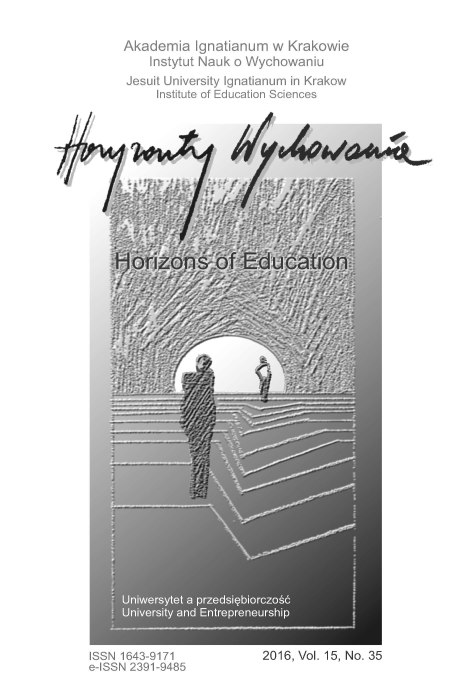Internal factors as a determinant of professional career paths of young people of Lower Silesia – results of own research
Abstract
RESEARCH OBJECTIVE: The aim of this article is to research whether and how the internal factors like: age, gender, competences and the value of life affect declared choices regarding career paths of young residents of Lower Silesia.
THE RESEARCH PROBLEM AND METHODS: The main problem of this publication is to analyse the results of a survey conducted among residents of Lower Silesia aged between 18 and 28 years. For the analysis results were used: Pearson's correlation coefficient, coefficient of variation, equality of means test, test for two indicators structure, chi-square independence test and cluster analysis.
THE PROCESS OF ARGUMENTATION: The line of reasoning begins analysis of the literature concerning career. Then the methodology of the study was presented. The main part of the article is based on quantitative analysis of the results of the conducted survey.
RESEARCH RESULTS: The largest group are undecided, that is those who do not have explicit vision of the future, but declare to plan that. In the group decided the most popular is the entrepreneurial career path means the business owners. Another group, as the popularity of the vision of professional future, are employees of a large company. The least popular career path is a government employee. Statistical analysis show that the selected internal factors do not determine the choice of the career paths of young people in Lower Silesia. In addition, it has been shown that young people appreciate the basic values like: health, family, friendship and honest life. Less important are the fame, success and adventurous life. According to research less relevant to young people are faith, religion and active participation in social and political life, which differs significantly from the generation of their grandparents. The area of research on self-selected competencies reveals that the young respondents have low self-esteem, which is contrary to the opinion of employers about young people on the labor market.
CONCLUSIONS, INNOVATIONS AND RECOMMENDATIONS: If internal factors don’t influence the choices of career path then perhaps external factors, originating from the surroundings, such as the environment and education, are more important. If so, that gives the grounds for further research and creates an opportunity to create professional future by favorable environmental conditions.References
Bohdziewicz, P. (2010). Modern career models from bureaucracy to entrepre¬neurship (Współczesne kariery zawodowe od modelu biurokratycznego do przedsiębiorczego). Zarządzanie Zasobami Ludzkimi, 3, 39-56.
Cybal Michalska, A. (2013). Młodzież akademicka a kariera zawodowa. Kraków: Oficyna Wydawnicza Impuls.
Ginn, M.E. (1998). Underpinning professional career development through a sys¬tems analysis methodology. Socio Economic Planning Sciences, 32(1), 67-81.
Hopper, E. (1971). Readings in the theory of educational systems. Notes on stratification, education and mobility in industrial societies. London: Hutchin¬son University Library.
Miś, A. (2007). Koncepcja rozwoju kariery zawodowej w organizacji. Zeszyty Naukowe/Uniwersytet Ekonomiczny w Krakowie. Seria Specjalna, Mono¬grafie, (183).
Pluta, J., Safin, K., Kulig Moskwa, K. i Strzelczyk, A. (2015). Aspiracje zawodo¬we a przedsiębiorczość młodzieży dolnośląskiej. Raport z badań. Wrocław: Wyższa Szkoła Bankowa.
Rutkowska, M. (2011). Specyfika zarządzania karierami talentów. W: T. Ingram (red.), Zarządzanie talentami. Teoria dla praktyki zarządzania zasobami ludz¬kimi. Warszawa: PWE.
Copyright (c) 2016 HORIZONS OF EDUCATION

This work is licensed under a Creative Commons Attribution-NonCommercial-NoDerivatives 4.0 International License.
Authors who publish in this journal agree to the following terms:
- Authors retain the copyright to their work while granting the journal the right of first publication. The work will be simultaneously licensed under a CC BY-ND license, which permits others to share the work with proper credit given to the author and the original publication in this journal.
- Authors may enter into additional, non-exclusive agreements for the distribution of the published version of the work (e.g., posting it in an institutional repository or publishing it in another journal), provided that the original publication in this journal is acknowledged.
We allow and encourage authors to share their work online (e.g., in institutional repositories or on personal websites) both before and during the submission process, as this can foster beneficial exchanges and lead to earlier and increased citations of the published work. (See The Effect of Open Access). We recommend using any of the following academic networking platforms:





